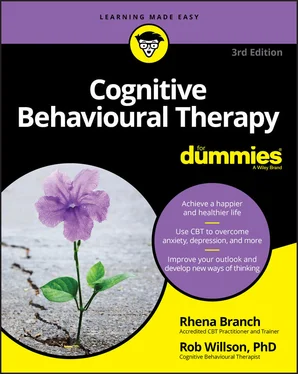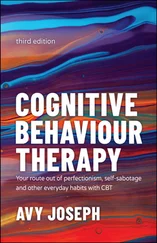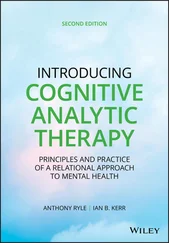Concentration exercise: Listening
For this exercise, sit back-to-back with someone else, perhaps a friend or your therapist. Ask the person to tell you a story for about two minutes. Concentrate on the story. Then, summarise the story: note how much of your attention you direct towards the task of listening to the other person, towards yourself and towards your environment – try using percentages to do this. Your partner can give you feedback on your summary to give you some idea how you did.
Now do the exercise again, but this time round sit face-to-face with the storyteller and make eye contact. Ask the person to tell you a story, but on this occasion consciously distract yourself by focusing on your thoughts and sensations, and then redirect your attention towards the storyteller. Summarise the story, and note (using percentages again) how you divide your attention between yourself, listening to the other person and your environment.
Repeat the storytelling activities, sitting back-to-back and then face-to-face, several times until you become readily able to redirect your attention to the task of listening after deliberate distraction through self-focusing. Doing so helps you to develop your ability to control where you focus your attention. Use a new story each time so that you don’t end up just memorizing the details!
Concentration exercise: Speaking
Follow the same steps for this speaking exercise as you do for the listening exercise, as we describe in the preceding section. Starting with your back to the back of the other person, tell a two-minute story, focusing your attention on making your story clear to the listener.
Next, position yourself face-to-face with the listener, making eye contact. Deliberately distract yourself from the task of storytelling by focusing on your feelings, sensations and thoughts. Then, refocus your attention towards what you’re saying and towards the listener, being aware of her reactions and whether she understands you.
Again, using percentages, monitor how you divide your attention among yourself, the task and your environment.
Concentration exercise: Graded practice
For this exercise, prepare two lists of situations. For your first list, write down five or so examples of situations you find non-threatening. As you write down the situations, practise distracting yourself by focusing on your internal sensations and thoughts. Now read back through the list of these situations, but this time try refocusing your attention outwards. For your second list, write down ten or so examples of situations you find threatening. Arrange the situations in a hierarchy, starting from the least anxiety-provoking and graduating up to the most anxiety-provoking. Now you can work through your hierarchy by deliberately entering the situations while practising task concentration until you reach the top of your list. This means you can start to practise mastering your anxiety in real-life situations.
Concentration exercise: Taking a walk
For this exercise, walk through a park, paying attention to what you hear, see, feel and smell. Focus your attention for a few minutes on different aspects of the world around you. First, focus your attention mainly to what you can hear. Then shift your attention to focus on smells, and then on to the feel of your feet on the ground, and so on. You can move your attention around to different sensations, which can help you tune your attention onto the outside world. Switching between your five senses can also help you realise that you have the ability to direct your attention as you choose.
After you’ve practised directing most of your attention to individual senses, try to integrate your attention to include all aspects of the park. Try to do this for at least 20 minutes. Really let yourself drink in the detail of your surroundings. Discover what hooks your attention. You may be drawn to water or have a keen interest in birds, plants, or perhaps even woodland smells. Notice how you feel much more relaxed and less self-conscious as you train your attention on the world around you.
Tuning in to tasks and the world around you
If you’re suffering from anxiety, you’re probably self-focused in many situations and fail to notice the rest of the world. On top of feeling unnecessarily uncomfortable, your self-focus means that you’re likely to miss out on a lot of interesting stuff. Luckily, you can change your attention bias and overcome much of your anxiety.
 You can also use re-training your attention onto the outside world to help interrupt yourself from engaging with the stream of negative thoughts that accompanies depression, which will help you to lift your mood.
You can also use re-training your attention onto the outside world to help interrupt yourself from engaging with the stream of negative thoughts that accompanies depression, which will help you to lift your mood.
Here’s an example of how you can use task-concentration techniques to overcome anxiety, specifically social phobia (see Chapter 9for more on social phobia).
Harold was particularly worried that people would notice that he blushed and sweated in social situations. He believed that people would think he was odd or a nervous wreck. Harold constantly self-monitored for blushing and sweating and tried very hard to mask these symptoms of his anxiety.
Here’s Harold’s list of situations, with each one becoming gradually more challenging:
1 Having dinner with his parents and brother
2 Socialising with his three closest mates at a local pub
3 Using public transport during quiet periods
4 Eating lunch with colleagues at work
5 Going to the cinema with a friend
6 Walking alone down a busy street
7 Socialising with strangers at a party
8 Going to the grocery shop alone
9 Going to the gym alone
10 Initiating conversation with strangers
11 Using public transport during busy periods
12 Eating alone in a restaurant
13 Going for an interview
14 Offering his opinion during work meetings
15 Giving a presentation at work
Harold used the principles of task concentration to increase his ability to focus deliberately on chosen external factors in non-threatening situations. When Harold was at the pub with his mates, he focused his attention on what his friends were saying, other people in the pub, the music and the general surroundings. Harold also deliberately distracted himself by focusing on whether he was blushing and sweating, and then he refocused his attention again.
Harold then used the same techniques in more-threatening situations. In the grocery store, Harold found that the more he focused on his blushing and sweating, the more anxious he felt and the less able he was to pack up his shopping. When he paid attention to the task of packing his groceries, made eye contact with the cashier and even made a bit of small talk, Harold’s anxiety symptoms reduced, and he became more aware of what he was doing and what was going on around him.
Harold worked diligently through his hierarchy of feared situations and now feels much more confident and relaxed in social situations.
 Imagine that you’re going to be called on by the police to act as an eyewitness. For a few minutes, try to take in as much information as you can about the environment and the people around you. What are people doing? What do they look like? Could you give a reliable description of someone an hour from now? Notice how much more detail you can recount when you choose to focus outwards, compared with when you’re concentrating on your thoughts and physical sensations.
Imagine that you’re going to be called on by the police to act as an eyewitness. For a few minutes, try to take in as much information as you can about the environment and the people around you. What are people doing? What do they look like? Could you give a reliable description of someone an hour from now? Notice how much more detail you can recount when you choose to focus outwards, compared with when you’re concentrating on your thoughts and physical sensations.
Читать дальше

 You can also use re-training your attention onto the outside world to help interrupt yourself from engaging with the stream of negative thoughts that accompanies depression, which will help you to lift your mood.
You can also use re-training your attention onto the outside world to help interrupt yourself from engaging with the stream of negative thoughts that accompanies depression, which will help you to lift your mood. Imagine that you’re going to be called on by the police to act as an eyewitness. For a few minutes, try to take in as much information as you can about the environment and the people around you. What are people doing? What do they look like? Could you give a reliable description of someone an hour from now? Notice how much more detail you can recount when you choose to focus outwards, compared with when you’re concentrating on your thoughts and physical sensations.
Imagine that you’re going to be called on by the police to act as an eyewitness. For a few minutes, try to take in as much information as you can about the environment and the people around you. What are people doing? What do they look like? Could you give a reliable description of someone an hour from now? Notice how much more detail you can recount when you choose to focus outwards, compared with when you’re concentrating on your thoughts and physical sensations.










